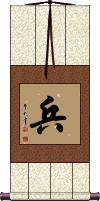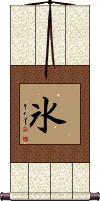Many custom options...
And formats...

Bing in Chinese / Japanese...
Buy a Bing calligraphy wall scroll here!
Personalize your custom “Bing” project by clicking the button next to your favorite “Bing” title below...
Ice / Frost
冰 is the Chinese character used to express “ice” or “frost.”
The main part of the character on the right holds the meaning of “water” and on the left, is a radical (the two dots) that also means water. Together, they create the character that means “ice” (solid water).
This is similar to the character for frost in Japanese. However, Japanese drop the radical from the left side.
Soldiers
兵 can be used to express soldiers, troops, a force, an army, weapons, arms, military, warfare, tactics, strategy, or warlike.
The final meaning depends on context. It's also part of the Chinese title for the Terracotta soldiers. In fact, this character is usually used in compound words (words of more than one character). Sometimes this single character is the title used for the pawns in a chess game (in a related issue, this is also a nickname for soldiers with the rank of Private).
Ice / Frost
冰 is the Japanese Kanji for “ice” or “frost.”
冰 is also the way to write “ice” in old Korean Hanja.
Note: This form is not commonly used anymore in Chinese - though still understood for the most part.
FYI: There was a time when Japan did not have a written language and simply absorbed Chinese characters into their language by meaning. When this occurred around the 5th century, the character shown here was a common but alternate way to write “ice” in Chinese, so it was the one that ended up being absorbed into the Japanese language. Not long after that, a similar thing happened in Korea - although Korea has replaced virtually all of the Chinese characters they once used with the new Hangul writing system.
Not the results for Bing that you were looking for?
Below are some entries from our dictionary that may match your Bing search...
| Characters If shown, 2nd row is Simp. Chinese |
Pronunciation Romanization |
Simple Dictionary Definition |
兵 see styles |
bīng bing1 ping minetoshi みねとし |
More info & calligraphy: Bing(1) (common) soldier; rank and file; (2) army; troops; (3) warfare; strategy; (personal name) Minetoshi |
冰 see styles |
bīng bing1 ping hiyou / hiyo ひよう |
More info & calligraphy: Ice / Frost(1) (archaism) ice; (2) hail; (personal name) Hiyou Ice, chaste. |
氷 冰 see styles |
bīng bing1 ping bin びん |
More info & calligraphy: Ice / Frost(1) (archaism) ice; (2) hail; (1) ice; (2) shaved ice (usually served with flavored simple syrup); (personal name) Bin Ice; chaste. |
兵法 see styles |
bīng fǎ bing1 fa3 ping fa heihou / heho へいほう |
More info & calligraphy: Art of Warart of war; strategy; tactics; (surname) Heihou |
冰島 冰岛 see styles |
bīng dǎo bing1 dao3 ping tao |
More info & calligraphy: Iceland |
冰球 see styles |
bīng qiú bing1 qiu2 ping ch`iu ping chiu |
More info & calligraphy: Ice Hockey |
士兵 see styles |
shì bīng shi4 bing1 shih ping |
More info & calligraphy: Soldier / Private |
工兵 see styles |
gōng bīng gong1 bing1 kung ping kouhei / kohe こうへい |
More info & calligraphy: Military Engineeringcombat engineer; military engineer; combat engineering; military engineering |
水兵 see styles |
shuǐ bīng shui3 bing1 shui ping suihei / suihe すいへい |
More info & calligraphy: Enlisted Sailor(naval) sailor |
溜冰 see styles |
liū bīng liu1 bing1 liu ping |
More info & calligraphy: Ice Skating |
丙 see styles |
bǐng bing3 ping minezaki みねざき |
third of the ten Heavenly Stems 十天干[shi2 tian1 gan1]; third in order; letter "C" or Roman "III" in list "A, B, C", or "I, II, III" etc; ancient Chinese compass point: 165°; propyl (1) (へい only) (See 甲乙丙丁) third rank; third class; third person (in a contract, etc.); (2) (esp. ひのえ) third sign of the Chinese calendar; (personal name) Minezaki Fire, heat, south; the third of the ten stems. |
並 并 see styles |
bìng bing4 ping minemura みねむら |
and; furthermore; also; together with; (not) at all; simultaneously; to combine; to join; to merge (n,n-suf) (1) average; medium; common; ordinary; (2) line; row of (e.g. houses); (3) mid-grade; (4) same level; equal; each (e.g. month); set of (e.g. teeth); (personal name) Minemura |
仌 see styles |
bīng bing1 ping |
old variant of 冰[bing1] |
併 并 see styles |
bìng bing4 ping mineyama みねやま |
to combine; to amalgamate (personal name) Mineyama |
倂 see styles |
bìng bing4 ping |
variant of 併|并[bing4] |
冫 see styles |
bīng bing1 ping |
"ice" radical in Chinese characters (Kangxi radical 15), occurring in 冰[bing1], 次[ci4] etc, known as 兩點水|两点水[liang3 dian3 shui3] |
寎 see styles |
bìng bing4 ping |
nightmare; start in sleep |
并 see styles |
bīng bing1 ping hyō |
short name for Taiyuan 太原[Tai4yuan2] to put together |
幷 see styles |
bìng bing4 ping hei |
variant of 並|并[bing4]; variant of 併|并[bing4] to put together |
怲 see styles |
bǐng bing3 ping |
sad; mournful |
抦 see styles |
bǐng bing3 ping |
old variant of 秉[bing3]; variant of 柄[bing3]; handle; shaft |
摒 see styles |
bìng bing4 ping |
to discard; to get rid of |
昞 see styles |
bǐng bing3 ping |
variant of 炳[bing3] |
昺 see styles |
bǐng bing3 ping |
bright; glorious |
柄 see styles |
bǐng bing3 ping fukumasu ふくます |
handle or shaft (of an axe etc); (of a flower, leaf or fruit) stem; something that affords an advantage to an opponent; classifier for knives or blades hilt (of a sword); haft (of a dagger); handle; handgrip; (personal name) Fukumasu A handle; authority, power. |
栟 see styles |
bīng bing1 ping |
Trachycarpus excelsa |
梹 see styles |
bīng bing1 ping |
variant of 檳|槟[bing1] |
檳 槟 see styles |
bīng bing1 ping hin |
betel palm (Areca catechu); betel nut; Taiwan pr. [bin1] The areca or betel-nut, i.e. 檳榔 pūga, the areca catechu, or betel-nut tree. |
炳 see styles |
bǐng bing3 ping hei / he へい |
bright; brilliant; luminous (adj-t,adv-to) (obsolete) bright; shining; clear; evident |
病 see styles |
bìng bing4 ping yamai やまい |
illness; CL:場|场[chang2]; disease; to fall ill; defect (1) illness; disease; (2) bad habit; weakness; fault Illness, disease; to hurt. |
Click here for more Bing results from our dictionary
The following table may be helpful for those studying Chinese or Japanese...
| Title | Characters | Romaji (Romanized Japanese) | Various forms of Romanized Chinese | |
| Ice Frost | 冰 | bīng / bing1 / bing | ping | |
| Soldiers | 兵 | hei | bīng / bing1 / bing | ping |
| Ice Frost | 冰 氷 | koori / kori | bīng / bing1 / bing | ping |
| In some entries above you will see that characters have different versions above and below a line. In these cases, the characters above the line are Traditional Chinese, while the ones below are Simplified Chinese. | ||||
Successful Chinese Character and Japanese Kanji calligraphy searches within the last few hours...






